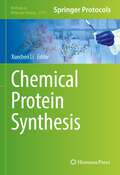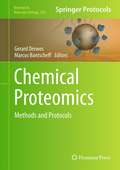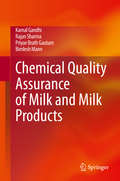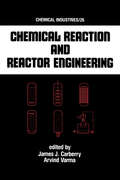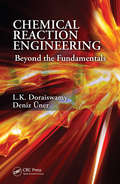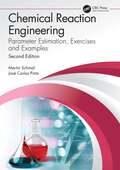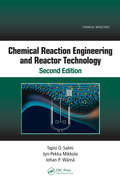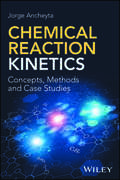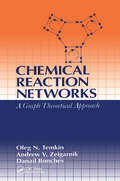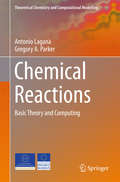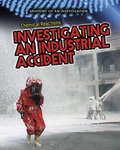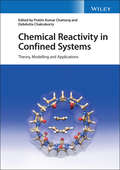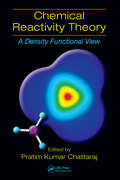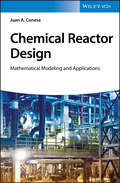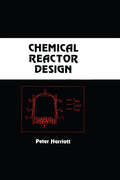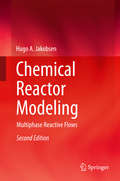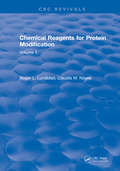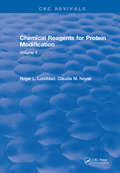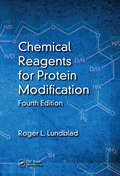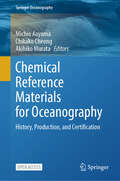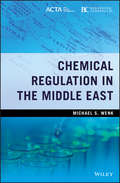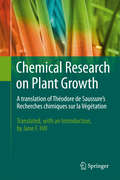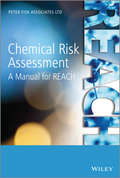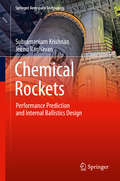- Table View
- List View
Chemical Protein Synthesis (Methods in Molecular Biology #2530)
by Xuechen LiThis volume provides updated protocols for chemical protein synthesis. Chapters guide readers through development methods, strategies, and applications of protein chemical synthesis. Written in the format of the highly successful Methods in Molecular Biology series, each chapter includes an introduction to the topic, lists necessary materials and reagents, includes tips on troubleshooting and known pitfalls, and step-by-step, readily reproducible protocols. Authoritative and cutting-edge, Chemical Protein Synthesis aims to be a useful and practical guide to new researchers and experts looking to expand their knowledge.
Chemical Proteomics: Methods and Protocols (Methods in Molecular Biology #803)
by Marcus Bantscheff Gerard DrewesThe multidisciplinary science of chemical proteomics studies how small molecules of synthetic or natural origin bind to proteins and modulate their function. In Chemical Proteomics: Methods and Protocols, expert researchers in the field provide key techniques to investigate chemical proteomics focusing on analytical strategies, how probes are generated, techniques for the discovery of small molecule targets and the probing of target function, and small molecule ligand and drug discovery. Written in the highly successful Methods in Molecular BiologyTM series format, chapters include introductions to their respective topics, lists of the necessary materials and reagents, step-by-step, readily reproducible laboratory protocols, and key tips on troubleshooting and avoiding known pitfalls. Authoritative and practical, Chemical Proteomics : Methods and Protocols seeks to provide methodologies that will contribute to a wider application of chemical proteomics methods in biochemical and cell biological laboratories.
Chemical Quality Assurance of Milk and Milk Products
by Kamal Gandhi Rajan Sharma Priyae Brath Gautam Bimlesh MannThis book discusses quality-related aspects of milk and milk products, covering the various analytical procedures for testing the quality and composition. It also describes the adulteration of milk and milk products and the common as well as advanced techniques used to detect such adulteration. Further, the book examines food laws, guidelines and regulations laid down by FSSAI, CODEX, ISO, IDF and USFDA, and addresses the functioning of a number of international and national organizations, including the WTO, Codex Alimentarius Commission, and BIS. Familiarizing readers with the concepts of QC, TQM, PDCA cycle and related concepts of quality assurance, the book also provides information on other topics that indirectly contribute to the quality of milk and milk products, like the calibration of milk testing equipment, quality of water used in milk processing and the standardization of various chemicals used for testing. This book is a valuable resource for researchers and industry professionals dealing with dairy products.
Chemical Reaction and Reactor Engineering
by James John CarberryThis book presents an authoritative progress report that will remain germane to the topic and prove to be a substantial inspiration to further progress. It is valuable to academic and industrial practitioners of the art and science of chemical reaction and reactor engineering.
Chemical Reaction Engineering: Beyond the Fundamentals
by L.K. Doraiswamy Deniz UnerFilling a longstanding gap for graduate courses in the field, Chemical Reaction Engineering: Beyond the Fundamentals covers basic concepts as well as complexities of chemical reaction engineering, including novel techniques for process intensification. The book is divided into three parts: Fundamentals Revisited, Building on Fundamentals, and Beyon
Chemical Reaction Engineering: Parameter Estimation, Exercises and Examples
by Martin Schmal José Carlos PintoThe first English edition of this book was published in 2014. This book was originally intended for undergraduate and graduate students and had one major objective: teach the basic concepts of kinetics and reactor design. The main reason behind the book is the fact that students frequently have great difficulty to explain the basic phenomena that occur in practice. Therefore, basic concepts with examples and many exercises are presented in each topic, instead of specific projects of the industry. The main objective was to provoke students to observe kinetic phenomena and to think about them. Indeed, reactors cannot be designed and operated without knowledge of kinetics. Additionally, the empirical nature of kinetic studies is recognized in the present edition of the book. For this reason, analyses related to how experimental errors affect kinetic studies are performed and illustrated with actual data. Particularly, analytical and numerical solutions are derived to represent the uncertainties of reactant conversions in distinct scenarios and are used to analyze the quality of the obtained parameter estimates. Consequently, new topics that focus on the development of analytical and numerical procedures for more accurate description of experimental errors in reaction systems and of estimates of kinetic parameters have been included in this version of the book. Finally, kinetics requires knowledge that must be complemented and tested in the laboratory. Therefore, practical examples of reactions performed in bench and semi-pilot scales are discussed in the final chapter. This edition of the book has been organized in two parts. In the first part, a thorough discussion regarding reaction kinetics is presented. In the second part, basic equations are derived and used to represent the performances of batch and continuous ideal reactors, isothermal and non-isothermal reaction systems and homogeneous and heterogeneous reactor vessels, as illustrated with several examples and exercises. This textbook will be of great value to undergraduate and graduate students in chemical engineering as well as to graduate students in and researchers of kinetics and catalysis.
Chemical Reaction Engineering and Reactor Technology, Second Edition (Chemical Industries)
by Tapio Salmi Johan Wärnå Jyri-Pekka MikkolaThe role of the chemical reactor is crucial for the industrial conversion of raw materials into products and numerous factors must be considered when selecting an appropriate and efficient chemical reactor. Chemical Reaction Engineering and Reactor Technology defines the qualitative aspects that affect the selection of an industrial chemical reactor and couples various reactor models to case-specific kinetic expressions for chemical processes. Thoroughly revised and updated, this much-anticipated Second Edition addresses the rapid academic and industrial development of chemical reaction engineering. Offering a systematic development of the chemical reaction engineering concept, this volume explores: essential stoichiometric, kinetic, and thermodynamic terms needed in the analysis of chemical reactors homogeneous and heterogeneous reactors reactor optimization aspects residence time distributions and non-ideal flow conditions in industrial reactors solutions of algebraic and ordinary differential equation systems gas- and liquid-phase diffusion coefficients and gas-film coefficients correlations for gas-liquid systems solubilities of gases in liquids guidelines for laboratory reactors and the estimation of kinetic parameters The authors pay special attention to the exact formulations and derivations of mass energy balances and their numerical solutions. Richly illustrated and containing exercises and solutions covering a number of processes, from oil refining to the development of specialty and fine chemicals, the text provides a clear understanding of chemical reactor analysis and design.
Chemical Reaction Kinetics: Concepts, Methods and Case Studies
by Jorge AncheytaA practical approach to chemical reaction kinetics—from basic concepts to laboratory methods—featuring numerous real-world examples and case studies This book focuses on fundamental aspects of reaction kinetics with an emphasis on mathematical methods for analyzing experimental data and interpreting results. It describes basic concepts of reaction kinetics, parameters for measuring the progress of chemical reactions, variables that affect reaction rates, and ideal reactor performance. Mathematical methods for determining reaction kinetic parameters are described in detail with the help of real-world examples and fully-worked step-by-step solutions. Both analytical and numerical solutions are exemplified. The book begins with an introduction to the basic concepts of stoichiometry, thermodynamics, and chemical kinetics. This is followed by chapters featuring in-depth discussions of reaction kinetics; methods for studying irreversible reactions with one, two and three components; reversible reactions; and complex reactions. In the concluding chapters the author addresses reaction mechanisms, enzymatic reactions, data reconciliation, parameters, and examples of industrial reaction kinetics. Throughout the book industrial case studies are presented with step-by-step solutions, and further problems are provided at the end of each chapter. Takes a practical approach to chemical reaction kinetics basic concepts and methods Features numerous illustrative case studies based on the author’s extensive experience in the industry Provides essential information for chemical and process engineers, catalysis researchers, and professionals involved in developing kinetic models Functions as a student textbook on the basic principles of chemical kinetics for homogeneous catalysis Describes mathematical methods to determine reaction kinetic parameters with the help of industrial case studies, examples, and step-by-step solutions Chemical Reaction Kinetics is a valuable working resource for academic researchers, scientists, engineers, and catalyst manufacturers interested in kinetic modeling, parameter estimation, catalyst evaluation, process development, reactor modeling, and process simulation. It is also an ideal textbook for undergraduate and graduate-level courses in chemical kinetics, homogeneous catalysis, chemical reaction engineering, and petrochemical engineering, biotechnology.
Chemical Reaction Networks: A Graph-Theoretical Approach
by Oleg N. Temkin Andrew V. Zeigarnik D.G. BonchevOver the last decade, increased attention to reaction dynamics, combined with the intensive application of computers in chemical studies, mathematical modeling of chemical processes, and mechanistic studies has brought graph theory to the forefront of research. It offers an advanced and powerful formalism for the description of chemical reactions and their intrinsic reaction mechanisms. Chemical Reaction Networks: A Graph-Theoretical Approach elegantly reviews and expands upon graph theory as applied to mechanistic theory, chemical kinetics, and catalysis. The authors explore various graph-theoretical approaches to canonical representation, numbering, and coding of elementary steps and chemical reaction mechanisms, the analysis of their topological structure, the complexity estimation, and classification of reaction mechanisms. They discuss topologically distinctive features of multiroute catalytic and noncatalytic and chain reactions involving metal complexes.With it's careful balance of clear language and mathematical rigor, the presentation of the authors' significant original work, and emphasis on practical applications and examples, Chemical Reaction Networks: A Graph Theoretical Approach is both an outstanding reference and valuable tool for chemical research.
Chemical Reactions: Basic Theory and Computing (Theoretical Chemistry and Computational Modelling)
by Gregory A. Parker Antonio LaganàThis graduate textbook, written by experienced lecturers, features the study and computation of efficient reactive processes. The text begins with the problem of determining the chemical reaction properties by first decomposing complex processes into their elementary components. Next, the problem of two colliding mass points is investigated and relationships between initial conditions and collision outcomes are discussed. The failure of classical approaches to match experimental information is discussed and a quantum formulation of the calculation of the properties of two colliding bodies is provided. The authors go onto describe how the formalism is extended to structured collision partners by discussing the methods used to compute the electronic structure of polyelectronic reactants and products and the formalism of atom diatom reactions. Additionally, the relationships between the features of the potential energy surface and the outcomes of the reactive dynamics, are discussed. Methods for computing quantum, classical, and semi-classical reactive probabilities based on the already discussed concepts and tools are also featured and the resulting main typical reactive behaviors are analyzed. Finally, the possibility of composing the computational tools and technologies needed to tackle more complex simulations as well as the various competences and distributed computing infrastructure needed for developing synergistic approaches to innovation are presented.
Chemical Reactions: Investigating an Industrial Accident (Anatomy of an Investigation)
by Richard SpilsburyThe calm of the night is shattered by an explosion and flames: a chemical factory is on fire, and a dangerous gas is drifting across town! This book looks at the topic of chemical reactions to explain the properties of chemicals and how they react, what has caused the explosion, and how the resulting fire and pollution can be tackled. It shows how the emergency services use their knowledge of science and technology to make the factory safe, and how investigators can analyze the evidence to determine the cause of the disaster.
Chemical Reactivity in Confined Systems: Theory, Modelling and Applications
by Pratim K ChattarajAn insightful analysis of confined chemical systems for theoretical and experimental scientists Chemical Reactivity in Confined Systems: Theory and Applications presents a theoretical basis for the molecular phenomena observed in confined spaces. The book highlights state-of-the-art theoretical and computational approaches, with a focus on obtaining physically relevant clarification of the subject to enable the reader to build an appreciation of underlying chemical principles. The book includes real-world examples of confined systems that highlight how the reactivity of atoms and molecules change upon encapsulation. Chapters include discussions on recent developments related to several host-guest systems, including cucurbit[n]uril, ExBox+4, clathrate hydrates, octa acid cavitand, metal organic frameworks (MOFs), covalent organic frameworks (COFs), zeolites, fullerenes, and carbon nanotubes. Readers will learn how to carry out new calculations to understand the physicochemical behavior of confined quantum systems. Topics covered include: A thorough introduction to global reactivity descriptors, including electronegativity, hardness, and electrophilicity An exploration of the Fukui function, as well as dual descriptors, higher order derivatives, and reactivity through information theory A practical discussion of spin dependent reactivity and temperature dependent reactivity Concise treatments of population analysis, reaction force, electron localization functions, and the solvent effect on reactivity Perfect for academic researchers and graduate students in theoretical and computational chemistry and confined chemical systems, Chemical Reactivity in Confined Systems: Theory and Applications will also earn a place in the libraries of professionals working in the areas of catalysis, supramolecular chemistry, and porous materials.
Chemical Reactivity Theory: A Density Functional View
by Pratim Kumar ChattarajIn the 1970s, Density Functional Theory (DFT) was borrowed from physics and adapted to chemistry by a handful of visionaries. Now chemical DFT is a diverse and rapidly growing field, its progress fueled by numerous developing practical descriptors that make DFT as useful as it is vast. With 34 chapters written by 65 eminent scientists from 13 diffe
Chemical Reactor Analysis and Applications for the Practicing Engineer
by Louis TheodoreThis books format follows an applications-oriented text and serves as a training tool for individuals in education and industry involved directly, or indirectly, with chemical reactors. It addresses both technical and calculational problems in this field. While this text can be complimented with texts on chemical kinetics and/or reactor design, it also stands alone as a self-teaching aid. The first part serves as an introduction to the subject title and contains chapters dealing with history, process variables, basic operations, kinetic principles, and conversion variables. The second part of the book addresses traditional reactor analysis; chapter topics include batch, CSTRs, tubular flow reactors, plus a comparison of these classes of reactors. Part 3 keys on reactor applications that include non-ideal reactors: thermal effects, interpretation of kinetic data, and reactor design. The book concludes with other reactor topics; chapter titles include catalysis, catalytic reactors, other reactions and reactors, and ABET-related topics. An extensive Appendix is also included
Chemical Reactor Design: Mathematical Modeling and Applications
by Juan A. ConesaA guide to the technical and calculation problems of chemical reactor analysis, scale-up, catalytic and biochemical reactor design Chemical Reactor Design offers a guide to the myriad aspects of reactor design including the use of numerical methods for solving engineering problems. The author - a noted expert on the topic - explores the use of transfer functions to study residence time distributions, convolution and deconvolution curves for reactor characterization, forced-unsteady-state-operation, scale-up of chemical reactors, industrial catalysis, design of multiphasic reactors, biochemical reactors design, as well as the design of multiphase gas-liquid-solid reactors. Chemical Reactor Design contains several examples of calculations and it gives special emphasis on the numerical solutions of differential equations by using the finite differences approximation, which offers the background information for understanding other more complex methods. The book is designed for the chemical engineering academic community and includes case studies on mathematical modeling by using of MatLab software. This important book: - Offers an up-to-date insight into the most important developments in the field of chemical, catalytic, and biochemical reactor engineering - Contains new aspects such as the use of numerical methods for solving engineering problems, transfer functions to study residence time distributions, and more - Includes illustrative case studies on MatLab approach, with emphasis on numerical solution of differential equations using the finite differences approximation Written for chemical engineers, mechanical engineers, chemists in industry, complex chemists, bioengineers, and process engineers, Chemical Reactor Design addresses the technical and calculation problems of chemical reactor analysis, scale-up, as well as catalytic and biochemical reactor design.
Chemical Reactor Design
by Peter HarriottFeaturing case studies and worked examples that illustrate key concepts in the text, this book contains guidelines for scaleup of laboratory and pilot plant results, methods to derive the correct reaction order, activation energy, or kinetic model from laboratory tests, and theories, correlations, and practical examples for 2- and 3-phase reaction
Chemical Reactor Modeling: Multiphase Reactive Flows
by Hugo A. JakobsenChemical Reactor Modeling closes the gap between Chemical Reaction Engineering and Fluid Mechanics The second edition consists of two volumes: Volume 1: Fundamentals. Volume 2: Chemical Engineering Applications In volume 1 most of the fundamental theory is presented. A few numerical model simulation application examples are given to elucidate the link between theory and applications. In volume 2 the chemical reactor equipment to be modeled are described. Several engineering models are introduced and discussed. A survey of the frequently used numerical methods, algorithms and schemes is provided. A few practical engineering applications of the modeling tools are presented and discussed. The working principles of several experimental techniques employed in order to get data for model validation are outlined. The monograph is based on lectures regularly taught in the fourth and fifth years graduate courses in transport phenomena and chemical reactor modeling and in a post graduate course in modern reactor modeling at the Norwegian University of Science and Technology, Department of Chemical Engineering, Trondheim, Norway. The objective of the book is to present the fundamentals of the single-fluid and multi-fluid models for the analysis of single and multiphase reactive flows in chemical reactors with a chemical reactor engineering rather than mathematical bias. Organized into 13 chapters, it combines theoretical aspects and practical applications and covers some of the recent research in several areas of chemical reactor engineering. This book contains a survey of the modern literature in the field of chemical reactor modeling.
Chemical Reagents for Protein Modification: Volume II
by Roger L. LundbladThe contents of this book are focused on the use of chemical modification to study the properties of proteins in solution. Particular emphasis has been placed on the practical laboratory aspects of this approach to the study of the relationship between structure and function in the complex class of biological heteropolymers. As a result, little emphasis is given to the individual consideration of the functional consequence of chemical modification.
Chemical Reagents for Protein Modification: Volume I
by Roger L. LundbladThe contents of this book are focused on the use of chemical modification to study the properties of proteins in solution. Particular emphasis has been placed on the practical laboratory aspects of this approach to the study of the relationship between structure and function in the complex class of biological heteropolymers.
Chemical Reagents for Protein Modification
by Roger L. LundbladThe use of the chemical modification of proteins has evolved over the past 80 years, benefiting from advances in analytical, physical, and organic chemistry. Over the past 30 years, the use of chemical reagents to modify proteins has been crucial in determining the function and structure of purified proteins. This groundbreaking work is part of the
Chemical Reference Materials for Oceanography: History, Production, and Certification (Springer Oceanography)
by Michio Aoyama Chikako Cheong Akihiko MurataThis open access book explores the history, production, and certification of reference materials for essential parameters in oceanography and provides a comprehensive understanding of them to readers. Because inorganic macro-nutrients, salinity, dissolved oxygen, and carbonate system parameters, including dissolved inorganic carbon, total alkalinity, and pH, are essential parameters in oceanography, they can be used to define biogeographic provinces, monitor ocean health, and detect decadal-scale oceanic climate changes. Without reference materials for these parameters, it would be difficult to produce reliable data sets or long-term baseline studies that are required to verify global change and oceanic stability. The book includes chapters on developing new reference materials for density, dissolved oxygen, dissolved organic carbon, dissolved organic matter, and trace metals, which are also important in oceanographic studies. The lead authors of each chapter regarding these parameters are top scientists in these areas; hence, this is the most comprehensive book of chemical reference materials for ocean science, written by experts in each field. The book is a useful resource for readers to find the latest information and status of certified reference materials (CRM) and reference materials (RM) and of ways to use CRM in their studies. We are in the middle of the United Nations Decade of Ocean Science for Sustainable Development (2021–2030), to which this book makes a timely contribution.
Chemical Regulation in the Middle East
by Michael S. WenkA noted expert offers a guide to the complex chemical regulations in the Middle East region Chemical Regulation in the Middle East offers an essential guide to the patchwork of chemical regulatory programs and the complex system of permits and licenses that manage chemicals in the countries of the Middle East. The book explores the range of ministry, legislative, and other decrees that encompass pesticides, occupational safety and health, as well as safety data sheets and product labels that address regulation to widely-varying degrees. The author explores the Cooperation Council for the Arab States of the Gulf and reviews the key regulatory agencies and chemical substance regulations. The text outlines the pesticide regulations, occupational safety and health regulations, waste regulations and safety data sheets and labels in Bahrain, Egypt, Israel, Kuwait, Oman, Pakistan, Saudi Arabia, United Arab Emirates and Abu Dhabi. This important guide: Offers a compendium of the diverse range of chemical regulations in the countries of the Middle East Untangles the complex system of permits and licenses that are unique to the various countries in the Middle East Contains information based on the research and experience of a noted expert in the field Includes a review of the key regulatory agencies and chemical substance regulations of the Arab States of the Gulf Written for chemical organisations and professionals doing business in the Middle East, Chemical Regulation in the Middle East offers a must-have resource that details the unique chemical regulations in each country in the region.
Chemical Research on Plant Growth: A translation of Théodore de Saussure's Recherches chimiques sur la Végétation by Jane F. Hill
by Jane F. Hill Théodore De SaussureRecherches Chimiques sur la Végétation was a seminal work in the development of the understanding of photosythesis and plant chemistry. The original publication, which was the first concise summation of the basics of plant nutrition, was a landmark in plant science. It was twice translated into German during the nineteenth century, but no English translation has been published. This translation will interest those in the plant, chemical, agricultural, and soil sciences, and the history of science, who find English more accessible than French or German and who wish to learn more about the early research on photosynthesis and plant science. Nicholas-Théodore de Saussure, a Swiss plant physiologist and plant chemist, was the last of the early pioneers of photosynthesis research. This initial period of research is generally considered to have begun with Jan van Helmont in the early seventeenth century and Stephen Hales in the first part of the eighteenth, then to have become more intense with Joseph Priestley, Jan Ingen-Housz, and Jean Senebier during the Scientific Revolution of the mid-to-late eighteenth century. Nicholas-Théodore's father, the famous Swiss geologist, meteorologist, and Alpine explorer Horace-Bénédict de Saussure, had been an early convert to the new chemical theories pioneered by Antoine Lavoisier in the late eighteenth century. Nicholas-Théodore, younger than his predecessors, had the full advantage of this new approach, which stressed quantitative chemical methods. Applying these methods to plants, Nicholas-Théodore de Saussure performed experiments that led him to major insights into plant nutrition. His most important contributions were the demonstration that water is a component of plant dry matter; that plants obtain their carbon from the carbon dioxide of the air, not from carbonic acid dissolved in the soil water, as most of his contemporaries believed; and that mineral elements and nitrogen from the soil are essential to plant growth. Further, he demonstrated the central fact of plant respiration (the absorption of oxygen and emission of carbon dioxide); and photosynthesis (the decomposition of carbon dioxide and evolution of oxygen in the light). In Recherches Chimiques sur la Végétation, de Saussure synthesized his own research findings with those of his predecessors, producing a pioneering work on plant nutrition. In the two centuries since Recherches Chimiques sur la Végétation was published, luminaries in various branches of science, including plant biology, chemistry, and soil science, have consistently praised it highly. In the nineteenth century, noted botanist Alphonse de Candolle and equally noted plant physiologist Julius von Sachs expressed great admiration for it. Although de Saussure's ideas were forgotten for a time, famed chemist Justus von Liebig, who invented artificial fertilizer, rediscovered them in the 1840s and brought them to the attention of the agricultural community, stressing their importance for increasing crop yields. In the twentieth century, eminent photosynthesis researcher Eugene Rabinowitch described Recherches Chimiques sur la Végétation as the first modern book on plant nutrition. Historian of chemistry Henry Leicester called the book a classic, noting that the first important generalization about biochemistry in the nineteenth century came from it. Plant physiologist P. E. Pilet stated that the book laid the foundations of a new science, phytochemistry. Soil scientist E. Walter Russell attributed to de Saussure the quantitative experimental method, which more than anything else made modern agricultural chemistry possible. Chemist Leonard K. Nash stated that de Saussure brought the studies of plant nutrition begun by Priestley, Ingen-Housz, and Senebier close to completion, finishing the basic experimental work and providing a convincing theoretical interpretation of the field, and also opened up new vistas of experiment and thought. A further note about the translation: This project is more t...
Chemical Risk Assessment
by Peter FiskThis book is an essential guide and support to understanding of the science and policy, procedure and practice that underpins the REACH risk assessments required for the use and placing on the market of chemicals in the European Union. A clear understanding of information provision and how this affects the assessment of chemical safety is fundamentally important to the success of policy on chemicals and ultimately to the sustainability of the chemicals industry. Within the book, the scientific processes that underpin the policy are explained in a practical way. Importantly, it includes coverage of techniques to help solve the problems of using potentially risky and hazardous chemicals through the use of less hazardous alternatives and 'green chemistry', and also the analysis of the risks of the use of the most hazardous substances against the social and economic benefits of use. Chemical Risk Assessment: A Manual for REACH covers the following main themes: i) Assessment of chemical risk; ii) Risk management; iii) Hazard reduction, substitution and green chemistry; iv) Risk versus benefit - socio-economic analysis. The book acts as a practical guide and overview to chemicals risk assessment and risk management (in the EU context), as well as a support text for planning for the challenges of the future, which will see ever-increasing pressure to withdraw hazardous substances from the EU (and global) market, balanced against opportunities for innovation in the development of less hazardous chemicals.
Chemical Rockets: Performance Prediction and Internal Ballistics Design (Springer Aerospace Technology)
by Subramaniam Krishnan Jeenu RaghavanThe purpose of this book is to discuss, at the graduate level, the methods of performance prediction for chemical rocket propulsion. A pedagogical presentation of such methods has been unavailable thus far and this text, based upon lectures, fills this gap. The first part contains the energy-minimization to calculate the propellant-combustion composition and the subsequent computation of rocket performance. While incremental analysis is for high performance solid motors, equilibrium-pressure analysis is for low performance ones. Both are detailed in the book's second part for the prediction of ignition and tail-off transients, and equilibrium operation. Computer codes, adopting the incremental analysis along with erosive burning effect, are included. The material is encouraged to be used and presented at lectures. Senior undergraduate and graduate students in universities, as well as practicing engineers and scientists in rocket industries, form the readership.
